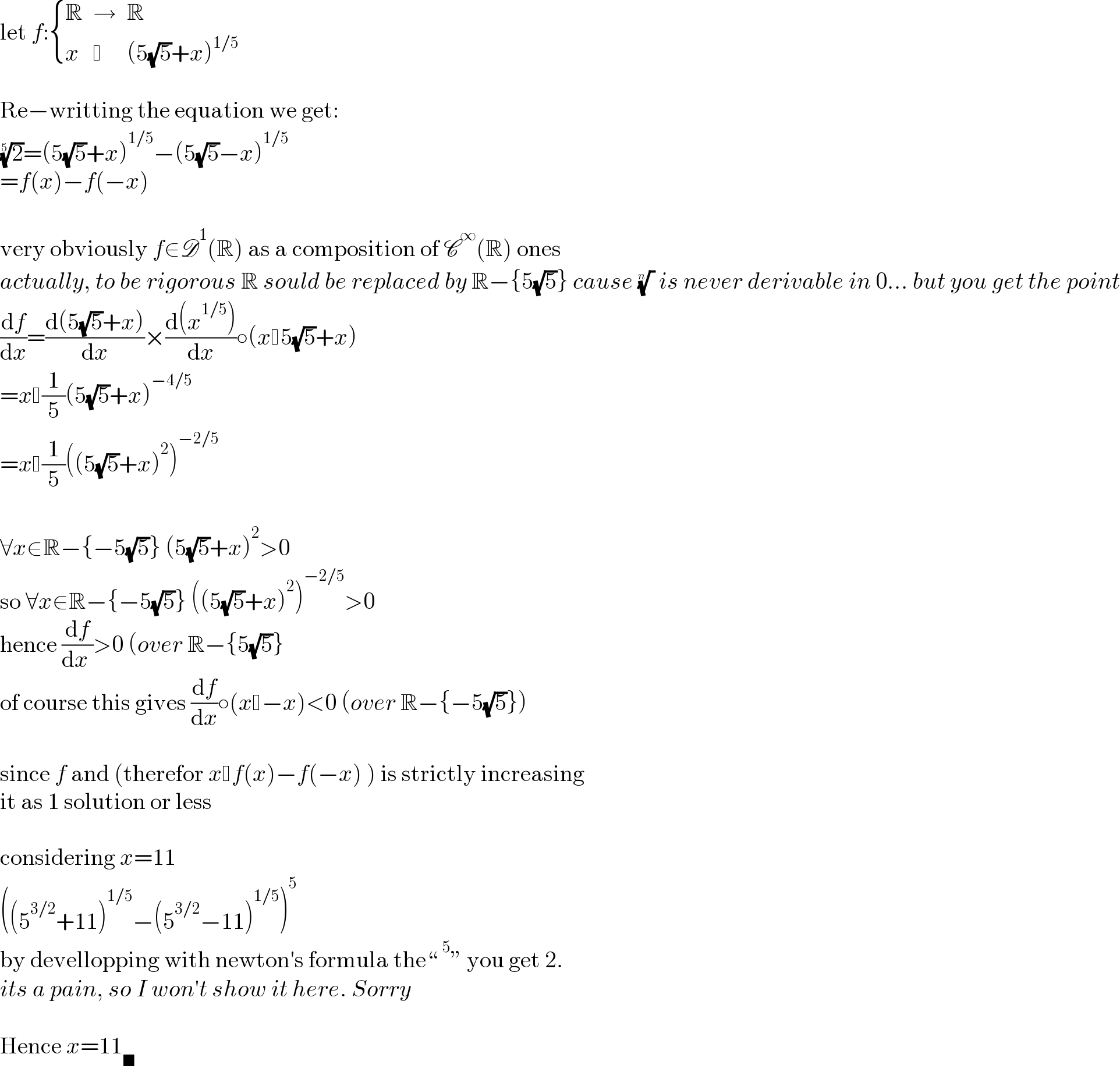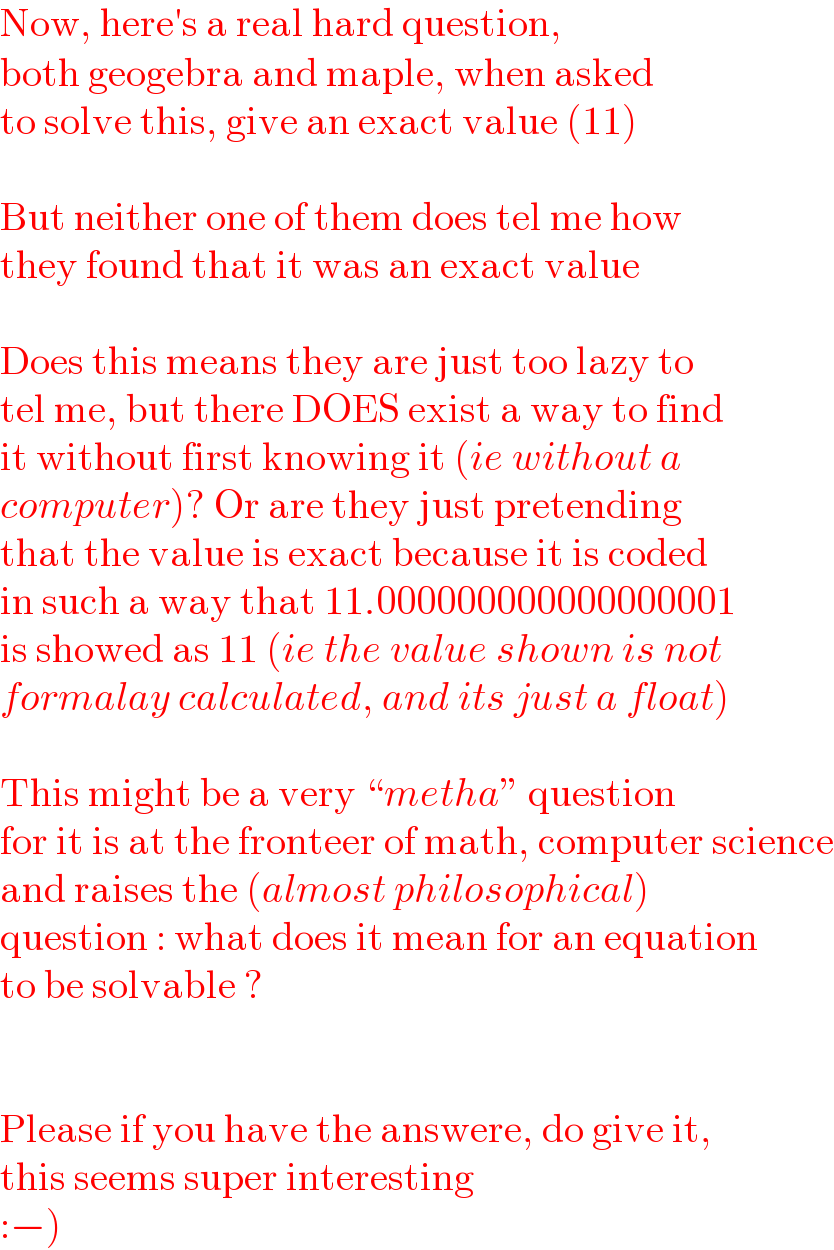
Question Number 154804 by mathdanisur last updated on 21/Sep/21

$$\mathrm{Solve}\:\mathrm{for}\:\mathrm{real}\:\mathrm{numbers}: \\ $$$$\sqrt[{\mathrm{5}}]{\mathrm{5}\sqrt{\mathrm{5}}\:+\:\mathrm{x}}\:-\:\sqrt[{\mathrm{5}}]{\mathrm{5}\sqrt{\mathrm{5}}\:-\:\mathrm{x}}\:=\:\sqrt[{\mathrm{5}}]{\mathrm{2}} \\ $$
Commented by 7770 last updated on 21/Sep/21

$$\mathrm{x}=\mathrm{11} \\ $$
Answered by TheHoneyCat last updated on 21/Sep/21

$$\mathrm{let}\:{f}:\begin{cases}{\mathbb{R}}&{\rightarrow}&{\mathbb{R}}\\{{x}}&{ }&{\left(\mathrm{5}\sqrt{\mathrm{5}}+{x}\right)^{\mathrm{1}/\mathrm{5}} }\end{cases} \\ $$$$ \\ $$$$\mathrm{Re}−\mathrm{writting}\:\mathrm{the}\:\mathrm{equation}\:\mathrm{we}\:\mathrm{get}: \\ $$$$\sqrt[{\mathrm{5}}]{\mathrm{2}}=\left(\mathrm{5}\sqrt{\mathrm{5}}+{x}\right)^{\mathrm{1}/\mathrm{5}} −\left(\mathrm{5}\sqrt{\mathrm{5}}−{x}\right)^{\mathrm{1}/\mathrm{5}} \\ $$$$={f}\left({x}\right)−{f}\left(−{x}\right) \\ $$$$ \\ $$$$\mathrm{very}\:\mathrm{obviously}\:{f}\in\mathscr{D}^{\mathrm{1}} \left(\mathbb{R}\right)\:\mathrm{as}\:\mathrm{a}\:\mathrm{composition}\:\mathrm{of}\:\mathscr{C}^{\infty} \left(\mathbb{R}\right)\:\mathrm{ones} \\ $$$${actually},\:{to}\:{be}\:{rigorous}\:\mathbb{R}\:{sould}\:{be}\:{replaced}\:{by}\:\mathbb{R}−\left\{\mathrm{5}\sqrt{\mathrm{5}}\right\}\:{cause}\:\sqrt[{{n}}]{\:}\:{is}\:{never}\:{derivable}\:{in}\:\mathrm{0}...\:{but}\:{you}\:{get}\:{the}\:{point} \\ $$$$\frac{\mathrm{d}{f}}{\mathrm{d}{x}}=\frac{\mathrm{d}\left(\mathrm{5}\sqrt{\mathrm{5}}+{x}\right)}{\mathrm{d}{x}}×\frac{\mathrm{d}\left({x}^{\mathrm{1}/\mathrm{5}} \right)}{\mathrm{d}{x}}\circ\left({x} \mathrm{5}\sqrt{\mathrm{5}}+{x}\right) \\ $$$$={x} \frac{\mathrm{1}}{\mathrm{5}}\left(\mathrm{5}\sqrt{\mathrm{5}}+{x}\right)^{−\mathrm{4}/\mathrm{5}} \\ $$$$={x} \frac{\mathrm{1}}{\mathrm{5}}\left(\left(\mathrm{5}\sqrt{\mathrm{5}}+{x}\right)^{\mathrm{2}} \right)^{−\mathrm{2}/\mathrm{5}} \\ $$$$ \\ $$$$\forall{x}\in\mathbb{R}−\left\{−\mathrm{5}\sqrt{\mathrm{5}}\right\}\:\left(\mathrm{5}\sqrt{\mathrm{5}}+{x}\right)^{\mathrm{2}} >\mathrm{0} \\ $$$$\mathrm{so}\:\forall{x}\in\mathbb{R}−\left\{−\mathrm{5}\sqrt{\mathrm{5}}\right\}\:\left(\left(\mathrm{5}\sqrt{\mathrm{5}}+{x}\right)^{\mathrm{2}} \right)^{−\mathrm{2}/\mathrm{5}} >\mathrm{0} \\ $$$$\mathrm{hence}\:\frac{\mathrm{d}{f}}{\mathrm{d}{x}\:}>\mathrm{0}\:\left({over}\:\mathbb{R}−\left\{\mathrm{5}\sqrt{\mathrm{5}}\right\}\right. \\ $$$$\mathrm{of}\:\mathrm{course}\:\mathrm{this}\:\mathrm{gives}\:\frac{\mathrm{d}{f}}{\mathrm{d}{x}}\circ\left({x} −{x}\right)<\mathrm{0}\:\left({over}\:\mathbb{R}−\left\{−\mathrm{5}\sqrt{\mathrm{5}}\right\}\right) \\ $$$$ \\ $$$$\mathrm{since}\:{f}\:\mathrm{and}\:\left(\mathrm{therefor}\:{x} {f}\left({x}\right)−{f}\left(−{x}\right)\:\right)\:\mathrm{is}\:\mathrm{strictly}\:\mathrm{increasing} \\ $$$$\mathrm{it}\:\mathrm{as}\:\mathrm{1}\:\mathrm{solution}\:\mathrm{or}\:\mathrm{less} \\ $$$$ \\ $$$$\mathrm{considering}\:{x}=\mathrm{11} \\ $$$$\left(\left(\mathrm{5}^{\mathrm{3}/\mathrm{2}} +\mathrm{11}\right)^{\mathrm{1}/\mathrm{5}} −\left(\mathrm{5}^{\mathrm{3}/\mathrm{2}} −\mathrm{11}\right)^{\mathrm{1}/\mathrm{5}} \right)^{\mathrm{5}} \\ $$$$\mathrm{by}\:\mathrm{devellopping}\:\mathrm{with}\:\mathrm{newton}'\mathrm{s}\:\mathrm{formula}\:\mathrm{the}``\:^{\mathrm{5}} ''\:\mathrm{you}\:\mathrm{get}\:\mathrm{2}. \\ $$$${its}\:{a}\:{pain},\:{so}\:{I}\:{won}'{t}\:{show}\:{it}\:{here}.\:{Sorry} \\ $$$$ \\ $$$$\mathrm{Hence}\:{x}=\mathrm{11}_{\blacksquare} \\ $$
Commented by TheHoneyCat last updated on 21/Sep/21

$${since}\:{the}\:{calculation}\:{was}\:``{a}\:{pain}''\:{you}\:{might}\:{wonder}\:{how}\:{I}\:{found}\:{that}\:{x}=\mathrm{11}\:{would}\:{work}\:{in}\:{the}\:{first}\:{place} \\ $$$${did}\:{I}\:{stubble}\:{upon}\:{it}\:{by}\:{pure}\:{luck}? \\ $$$${well},\:{not}\:{at}\:{all},\:{actualy}\:{this}\:{whole}\:{proof}\:{is}\:{the}\:{opposite}\:{of}\:{what}\:{I}\:{did}\:{by}\:{myself} \\ $$$${I}\:{actualy}\:{plotted}\:{the}\:{curve}\:{on}\:{a}\:{graph}\:{and}\:{found}\:\left({to}\:{a}\:{very}\:{good}\:{precision}\right)\:{that}\:{the}\:{only}\:{solution}\:{was}\:{indeed}\:\mathrm{11} \\ $$$${I}\:{then}\:{just}\:{had}\:{to}\:{proove}\:{the}\:{unicity}\:{and}\:{verify}\:{that}\:\mathrm{11}\:{was}\:{not}\:{just}\:{an}\:{approximation} \\ $$$${see}\:{the}\:{folowing}\:{pictures}\:{I}\:{plotted}. \\ $$
Commented by TheHoneyCat last updated on 21/Sep/21

$$\mathrm{Here}\:\mathrm{is}\:\mathrm{the}\:\mathrm{equation}\:\left({twisted}\:{to}\:{get}\:{an}\:``=\mathrm{0}''\:{statement}\right) \\ $$
Commented by TheHoneyCat last updated on 21/Sep/21

Commented by TheHoneyCat last updated on 21/Sep/21

$$\mathrm{and}\:\mathrm{here}\:\mathrm{is}\:\mathrm{the}\:\mathrm{derivative} \\ $$$$\left({I}\:{wonted}\:{to}\:{make}\:{sure}\:{it}\:{was}\:{indeed}\:>\mathrm{0}\right. \\ $$$$\left.{if}\:{it}\:{hadn}'{t}\:{been},\:{I}\:{would}\:{have}\:{not}\:{tried}\:{trought}\:{this}\:{method}\right) \\ $$
Commented by TheHoneyCat last updated on 21/Sep/21

Commented by TheHoneyCat last updated on 21/Sep/21

$$\mathrm{Now},\:\mathrm{here}'\mathrm{s}\:\mathrm{a}\:\mathrm{real}\:\mathrm{hard}\:\mathrm{question}, \\ $$$$\mathrm{both}\:\mathrm{geogebra}\:\mathrm{and}\:\mathrm{maple},\:\mathrm{when}\:\mathrm{asked}\: \\ $$$$\mathrm{to}\:\mathrm{solve}\:\mathrm{this},\:\mathrm{give}\:\mathrm{an}\:\mathrm{exact}\:\mathrm{value}\:\left(\mathrm{11}\right) \\ $$$$ \\ $$$$\mathrm{But}\:\mathrm{neither}\:\mathrm{one}\:\mathrm{of}\:\mathrm{them}\:\mathrm{does}\:\mathrm{tel}\:\mathrm{me}\:\mathrm{how} \\ $$$$\mathrm{they}\:\mathrm{found}\:\mathrm{that}\:\mathrm{it}\:\mathrm{was}\:\mathrm{an}\:\mathrm{exact}\:\mathrm{value} \\ $$$$ \\ $$$$\mathrm{Does}\:\mathrm{this}\:\mathrm{means}\:\mathrm{they}\:\mathrm{are}\:\mathrm{just}\:\mathrm{too}\:\mathrm{lazy}\:\mathrm{to} \\ $$$$\mathrm{tel}\:\mathrm{me},\:\mathrm{but}\:\mathrm{there}\:\mathrm{DOES}\:\mathrm{exist}\:\mathrm{a}\:\mathrm{way}\:\mathrm{to}\:\mathrm{find}\: \\ $$$$\mathrm{it}\:\mathrm{without}\:\mathrm{first}\:\mathrm{knowing}\:\mathrm{it}\:\left({ie}\:{without}\:{a}\:\right. \\ $$$$\left.{computer}\right)?\:\mathrm{Or}\:\mathrm{are}\:\mathrm{they}\:\mathrm{just}\:\mathrm{pretending} \\ $$$$\mathrm{that}\:\mathrm{the}\:\mathrm{value}\:\mathrm{is}\:\mathrm{exact}\:\mathrm{because}\:\mathrm{it}\:\mathrm{is}\:\mathrm{coded} \\ $$$$\mathrm{in}\:\mathrm{such}\:\mathrm{a}\:\mathrm{way}\:\mathrm{that}\:\mathrm{11}.\mathrm{000000000000000001} \\ $$$$\mathrm{is}\:\mathrm{showed}\:\mathrm{as}\:\mathrm{11}\:\left({ie}\:{the}\:{value}\:{shown}\:{is}\:{not}\right. \\ $$$$\left.{formalay}\:{calculated},\:{and}\:{its}\:{just}\:{a}\:{float}\right) \\ $$$$ \\ $$$$\mathrm{This}\:\mathrm{might}\:\mathrm{be}\:\mathrm{a}\:\mathrm{very}\:``{metha}''\:\mathrm{question}\: \\ $$$$\mathrm{for}\:\mathrm{it}\:\mathrm{is}\:\mathrm{at}\:\mathrm{the}\:\mathrm{fronteer}\:\mathrm{of}\:\mathrm{math},\:\mathrm{computer}\:\mathrm{science} \\ $$$$\mathrm{and}\:\mathrm{raises}\:\mathrm{the}\:\left({almost}\:{philosophical}\right)\: \\ $$$$\mathrm{question}\::\:\mathrm{what}\:\mathrm{does}\:\mathrm{it}\:\mathrm{mean}\:\mathrm{for}\:\mathrm{an}\:\mathrm{equation} \\ $$$$\mathrm{to}\:\mathrm{be}\:\mathrm{solvable}\:? \\ $$$$ \\ $$$$ \\ $$$$\mathrm{Please}\:\mathrm{if}\:\mathrm{you}\:\mathrm{have}\:\mathrm{the}\:\mathrm{answere},\:\mathrm{do}\:\mathrm{give}\:\mathrm{it}, \\ $$$$\mathrm{this}\:\mathrm{seems}\:\mathrm{super}\:\mathrm{interesting} \\ $$$$\left.:−\right) \\ $$
Commented by mathdanisur last updated on 21/Sep/21
![let a=5(√5)+x ; b=5(√5)-x then a-b=(2)^(1/5) ; a^5 -b^5 =2x and a^5 +b^5 =10(√5) then (a/( (2)^(1/5) ))-(b/( (2)^(1/5) ))=1 ; ((a/( (2)^(1/5) )))^5 -((b/( (2)^(1/5) )))^5 =x and ((a/( (2)^(1/5) )))^5 +((b/( (2)^(1/5) )))^5 =5(√5) let (a/( (2)^(1/5) ))=p and (b/( (2)^(1/5) ))=q we have p-q=1 (1) ; p^5 -q^5 =x (2) ; p^5 +q^5 =5(√5) (3) also we knov p^5 +q^5 =(p+q)[(p-q)^2 ((p-q)^2 +4pq)+2p^2 q^2 -pq((p-q)^2 +pq)] now 5(√5)=(p+q)(p^2 q^2 +3pq+1) squaring 125=(p+q)^2 (p^2 q^2 +3pq+1)^2 5^3 =(1+4pq)(p^2 q^2 +3pq+1)^2 ⇔ pq=1 doing (3)^2 -(2)^2 ⇒ 4(pq)^5 =125-x^2 ⇔ x^2 =121 ⇔ x=±11 since x=-11 does not satisfy we get x=11](Q154836.png)
$$\mathrm{let}\:\:\mathrm{a}=\mathrm{5}\sqrt{\mathrm{5}}+\mathrm{x}\:\:;\:\:\mathrm{b}=\mathrm{5}\sqrt{\mathrm{5}}-\mathrm{x} \\ $$$$\mathrm{then}\:\:\mathrm{a}-\mathrm{b}=\sqrt[{\mathrm{5}}]{\mathrm{2}}\:\:;\:\:\mathrm{a}^{\mathrm{5}} -\mathrm{b}^{\mathrm{5}} =\mathrm{2x}\:\:\mathrm{and}\:\:\mathrm{a}^{\mathrm{5}} +\mathrm{b}^{\mathrm{5}} =\mathrm{10}\sqrt{\mathrm{5}} \\ $$$$\mathrm{then}\:\:\frac{\mathrm{a}}{\:\sqrt[{\mathrm{5}}]{\mathrm{2}}}-\frac{\mathrm{b}}{\:\sqrt[{\mathrm{5}}]{\mathrm{2}}}=\mathrm{1}\:\:;\:\:\left(\frac{\mathrm{a}}{\:\sqrt[{\mathrm{5}}]{\mathrm{2}}}\right)^{\mathrm{5}} -\left(\frac{\mathrm{b}}{\:\sqrt[{\mathrm{5}}]{\mathrm{2}}}\right)^{\mathrm{5}} =\mathrm{x}\:\:\mathrm{and}\:\:\left(\frac{\mathrm{a}}{\:\sqrt[{\mathrm{5}}]{\mathrm{2}}}\right)^{\mathrm{5}} +\left(\frac{\mathrm{b}}{\:\sqrt[{\mathrm{5}}]{\mathrm{2}}}\right)^{\mathrm{5}} =\mathrm{5}\sqrt{\mathrm{5}} \\ $$$$\mathrm{let}\:\:\frac{\mathrm{a}}{\:\sqrt[{\mathrm{5}}]{\mathrm{2}}}=\mathrm{p}\:\:\mathrm{and}\:\:\frac{\mathrm{b}}{\:\sqrt[{\mathrm{5}}]{\mathrm{2}}}=\mathrm{q} \\ $$$$\mathrm{we}\:\mathrm{have}\:\:\mathrm{p}-\mathrm{q}=\mathrm{1}\:\left(\mathrm{1}\right)\:;\:\mathrm{p}^{\mathrm{5}} -\mathrm{q}^{\mathrm{5}} =\mathrm{x}\:\left(\mathrm{2}\right)\:;\:\mathrm{p}^{\mathrm{5}} +\mathrm{q}^{\mathrm{5}} =\mathrm{5}\sqrt{\mathrm{5}}\:\left(\mathrm{3}\right) \\ $$$$\mathrm{also}\:\mathrm{we}\:\mathrm{knov}\:\:\mathrm{p}^{\mathrm{5}} +\mathrm{q}^{\mathrm{5}} =\left(\mathrm{p}+\mathrm{q}\right)\left[\left(\mathrm{p}-\mathrm{q}\right)^{\mathrm{2}} \left(\left(\mathrm{p}-\mathrm{q}\right)^{\mathrm{2}} +\mathrm{4pq}\right)+\mathrm{2p}^{\mathrm{2}} \mathrm{q}^{\mathrm{2}} -\mathrm{pq}\left(\left(\mathrm{p}-\mathrm{q}\right)^{\mathrm{2}} +\mathrm{pq}\right)\right] \\ $$$$\mathrm{now}\:\:\mathrm{5}\sqrt{\mathrm{5}}=\left(\mathrm{p}+\mathrm{q}\right)\left(\mathrm{p}^{\mathrm{2}} \mathrm{q}^{\mathrm{2}} +\mathrm{3pq}+\mathrm{1}\right) \\ $$$$\mathrm{squaring}\:\:\mathrm{125}=\left(\mathrm{p}+\mathrm{q}\right)^{\mathrm{2}} \left(\mathrm{p}^{\mathrm{2}} \mathrm{q}^{\mathrm{2}} +\mathrm{3pq}+\mathrm{1}\right)^{\mathrm{2}} \\ $$$$\mathrm{5}^{\mathrm{3}} =\left(\mathrm{1}+\mathrm{4pq}\right)\left(\mathrm{p}^{\mathrm{2}} \mathrm{q}^{\mathrm{2}} +\mathrm{3pq}+\mathrm{1}\right)^{\mathrm{2}} \:\Leftrightarrow\:\mathrm{pq}=\mathrm{1} \\ $$$$\mathrm{doing}\:\:\left(\mathrm{3}\right)^{\mathrm{2}} -\left(\mathrm{2}\right)^{\mathrm{2}} \\ $$$$\Rightarrow\:\mathrm{4}\left(\mathrm{pq}\right)^{\mathrm{5}} =\mathrm{125}-\mathrm{x}^{\mathrm{2}} \:\Leftrightarrow\:\mathrm{x}^{\mathrm{2}} =\mathrm{121}\:\Leftrightarrow\:\mathrm{x}=\pm\mathrm{11} \\ $$$$\mathrm{since}\:\:\mathrm{x}=-\mathrm{11}\:\:\mathrm{does}\:\mathrm{not}\:\mathrm{satisfy} \\ $$$$\mathrm{we}\:\mathrm{get}\:\:\mathrm{x}=\mathrm{11} \\ $$
Commented by mathdanisur last updated on 21/Sep/21

$$\mathrm{Dear}\:\boldsymbol{\mathrm{S}}\mathrm{er},\:\mathrm{thanks}\:\mathrm{for}\:\mathrm{the}\:\mathrm{amazing}\:\mathrm{and} \\ $$$$\mathrm{interesting}\:\mathrm{questions} \\ $$
Commented by MJS_new last updated on 22/Sep/21

$$\mathrm{it}'\mathrm{s}\:\mathrm{not}\:\mathrm{a}\:\mathrm{proper}\:\mathrm{proof} \\ $$$$\mathrm{in}\:\mathrm{line}\:\mathrm{9}\:\mathrm{you}\:\mathrm{get}\:{pq}=\mathrm{1} \\ $$$$\mathrm{but}\:{p}=\frac{{a}}{\:\sqrt[{\mathrm{5}}]{\mathrm{2}}}=\frac{\mathrm{11}+\mathrm{5}\sqrt{\mathrm{5}}}{\:\sqrt[{\mathrm{5}}]{\mathrm{2}}}\wedge{q}=\frac{{b}}{\:\sqrt[{\mathrm{5}}]{\mathrm{2}}}=\frac{−\mathrm{11}+\mathrm{5}\sqrt{\mathrm{5}}}{\:\sqrt[{\mathrm{5}}]{\mathrm{2}}} \\ $$$$\Rightarrow\:{pq}=\mathrm{2}^{\mathrm{8}/\mathrm{5}} \neq\mathrm{1} \\ $$
Answered by MJS_new last updated on 22/Sep/21
![how to omit the ((...))^(1/5) [(∗) marks where we introduce false solutions] a^(1/5) +b^(1/5) =c^(1/5) a+5a^(4/5) b^(1/5) +10a^(3/5) b^(2/5) +10a^(2/5) b^(3/5) +5a^(1/5) b^(4/5) +b=c (∗) 5a^(1/5) b^(1/5) (a^(3/5) +2a^(2/5) b^(1/5) +2a^(1/5) b^(2/5) +b^(3/5) )=c−a−b a^(3/5) +2a^(2/5) b^(1/5) +2a^(1/5) b^(2/5) +b^(3/5) =((c−a−b)/(5a^(1/5) b^(1/5) )) (a^(1/5) +b^(1/5) )_(=c^(1/5) ) (a^(2/5) +a^(1/5) b^(1/5) +b^(2/5) )=((c−a−b)/(5a^(1/5) b^(1/5) )) a^(2/5) +a^(1/5) b^(1/5) +b^(2/5) =((c−a−b)/(5a^(1/5) b^(1/5) c^(1/5) )) now this is what I found 5(x^2 +xy+y^2 )^5 =x^(10) +y^(10) +(x+y)^(10) +3(x^5 (x+y)^5 +y^5 (x+y)^5 −x^5 y^5 ) in our case x=a^(1/5) ∧y=b^(1/5) ∧(x+y)=c^(1/5) ⇒ 5(a^(2/5) +a^(1/5) b^(1/5) +b^(2/5) )^5 =a^2 +b^2 +c^2 +3(ac+bc−ab) so we can go on (a^(2/5) +a^(1/5) b^(1/5) +b^(2/5) =((c−a−b)/(5a^(1/5) b^(1/5) c^(1/5) )))^5 (∗) (1/5)(a^2 +b^2 +c^2 +3(ac+bc−ab))=(((c−a−b)^5 )/(3125abc)) now a=x+5(√5)∧b=x−5(√5)∧c=2 −((x^2 −12x−629)/5)=((−16(x−1)^5 )/(3125(x^2 −125))) x^5 −((705)/(16))x^4 +((1915)/4)x^3 +((235545)/8)x^2 −((234355)/4)x−((49140641)/(16))=0 49140641=11^2 ×101×4021 and luckily x=11 is a solution no other solution ∈R](Q154863.png)
$$\mathrm{how}\:\mathrm{to}\:\mathrm{omit}\:\mathrm{the}\:\sqrt[{\mathrm{5}}]{...} \\ $$$$ \\ $$$$\:\:\:\:\:\left[\left(\ast\right)\:\mathrm{marks}\:\mathrm{where}\:\mathrm{we}\:\mathrm{introduce}\:\mathrm{false}\:\mathrm{solutions}\right] \\ $$$$ \\ $$$${a}^{\frac{\mathrm{1}}{\mathrm{5}}} +{b}^{\frac{\mathrm{1}}{\mathrm{5}}} ={c}^{\frac{\mathrm{1}}{\mathrm{5}}} \\ $$$${a}+\mathrm{5}{a}^{\frac{\mathrm{4}}{\mathrm{5}}} {b}^{\frac{\mathrm{1}}{\mathrm{5}}} +\mathrm{10}{a}^{\frac{\mathrm{3}}{\mathrm{5}}} {b}^{\frac{\mathrm{2}}{\mathrm{5}}} +\mathrm{10}{a}^{\frac{\mathrm{2}}{\mathrm{5}}} {b}^{\frac{\mathrm{3}}{\mathrm{5}}} +\mathrm{5}{a}^{\frac{\mathrm{1}}{\mathrm{5}}} {b}^{\frac{\mathrm{4}}{\mathrm{5}}} +{b}={c}\:\:\left(\ast\right) \\ $$$$\mathrm{5}{a}^{\frac{\mathrm{1}}{\mathrm{5}}} {b}^{\frac{\mathrm{1}}{\mathrm{5}}} \left({a}^{\frac{\mathrm{3}}{\mathrm{5}}} +\mathrm{2}{a}^{\frac{\mathrm{2}}{\mathrm{5}}} {b}^{\frac{\mathrm{1}}{\mathrm{5}}} +\mathrm{2}{a}^{\frac{\mathrm{1}}{\mathrm{5}}} {b}^{\frac{\mathrm{2}}{\mathrm{5}}} +{b}^{\frac{\mathrm{3}}{\mathrm{5}}} \right)={c}−{a}−{b} \\ $$$${a}^{\frac{\mathrm{3}}{\mathrm{5}}} +\mathrm{2}{a}^{\frac{\mathrm{2}}{\mathrm{5}}} {b}^{\frac{\mathrm{1}}{\mathrm{5}}} +\mathrm{2}{a}^{\frac{\mathrm{1}}{\mathrm{5}}} {b}^{\frac{\mathrm{2}}{\mathrm{5}}} +{b}^{\frac{\mathrm{3}}{\mathrm{5}}} =\frac{{c}−{a}−{b}}{\mathrm{5}{a}^{\frac{\mathrm{1}}{\mathrm{5}}} {b}^{\frac{\mathrm{1}}{\mathrm{5}}} } \\ $$$$\underset{={c}^{\frac{\mathrm{1}}{\mathrm{5}}} } {\underbrace{\left({a}^{\frac{\mathrm{1}}{\mathrm{5}}} +{b}^{\frac{\mathrm{1}}{\mathrm{5}}} \right)}}\left({a}^{\frac{\mathrm{2}}{\mathrm{5}}} +{a}^{\frac{\mathrm{1}}{\mathrm{5}}} {b}^{\frac{\mathrm{1}}{\mathrm{5}}} +{b}^{\frac{\mathrm{2}}{\mathrm{5}}} \right)=\frac{{c}−{a}−{b}}{\mathrm{5}{a}^{\frac{\mathrm{1}}{\mathrm{5}}} {b}^{\frac{\mathrm{1}}{\mathrm{5}}} } \\ $$$${a}^{\frac{\mathrm{2}}{\mathrm{5}}} +{a}^{\frac{\mathrm{1}}{\mathrm{5}}} {b}^{\frac{\mathrm{1}}{\mathrm{5}}} +{b}^{\frac{\mathrm{2}}{\mathrm{5}}} =\frac{{c}−{a}−{b}}{\mathrm{5}{a}^{\frac{\mathrm{1}}{\mathrm{5}}} {b}^{\frac{\mathrm{1}}{\mathrm{5}}} {c}^{\frac{\mathrm{1}}{\mathrm{5}}} } \\ $$$$ \\ $$$$\mathrm{now}\:\mathrm{this}\:\mathrm{is}\:\mathrm{what}\:\mathrm{I}\:\mathrm{found} \\ $$$$\mathrm{5}\left({x}^{\mathrm{2}} +{xy}+{y}^{\mathrm{2}} \right)^{\mathrm{5}} ={x}^{\mathrm{10}} +{y}^{\mathrm{10}} +\left({x}+{y}\right)^{\mathrm{10}} +\mathrm{3}\left({x}^{\mathrm{5}} \left({x}+{y}\right)^{\mathrm{5}} +{y}^{\mathrm{5}} \left({x}+{y}\right)^{\mathrm{5}} −{x}^{\mathrm{5}} {y}^{\mathrm{5}} \right) \\ $$$$\mathrm{in}\:\mathrm{our}\:\mathrm{case}\:{x}={a}^{\frac{\mathrm{1}}{\mathrm{5}}} \wedge{y}={b}^{\frac{\mathrm{1}}{\mathrm{5}}} \wedge\left({x}+{y}\right)={c}^{\frac{\mathrm{1}}{\mathrm{5}}} \\ $$$$\Rightarrow \\ $$$$\mathrm{5}\left({a}^{\frac{\mathrm{2}}{\mathrm{5}}} +{a}^{\frac{\mathrm{1}}{\mathrm{5}}} {b}^{\frac{\mathrm{1}}{\mathrm{5}}} +{b}^{\frac{\mathrm{2}}{\mathrm{5}}} \right)^{\mathrm{5}} ={a}^{\mathrm{2}} +{b}^{\mathrm{2}} +{c}^{\mathrm{2}} +\mathrm{3}\left({ac}+{bc}−{ab}\right) \\ $$$$\mathrm{so}\:\mathrm{we}\:\mathrm{can}\:\mathrm{go}\:\mathrm{on} \\ $$$$\left({a}^{\frac{\mathrm{2}}{\mathrm{5}}} +{a}^{\frac{\mathrm{1}}{\mathrm{5}}} {b}^{\frac{\mathrm{1}}{\mathrm{5}}} +{b}^{\frac{\mathrm{2}}{\mathrm{5}}} =\frac{{c}−{a}−{b}}{\mathrm{5}{a}^{\frac{\mathrm{1}}{\mathrm{5}}} {b}^{\frac{\mathrm{1}}{\mathrm{5}}} {c}^{\frac{\mathrm{1}}{\mathrm{5}}} }\right)^{\mathrm{5}} \:\left(\ast\right) \\ $$$$\frac{\mathrm{1}}{\mathrm{5}}\left({a}^{\mathrm{2}} +{b}^{\mathrm{2}} +{c}^{\mathrm{2}} +\mathrm{3}\left({ac}+{bc}−{ab}\right)\right)=\frac{\left({c}−{a}−{b}\right)^{\mathrm{5}} }{\mathrm{3125}{abc}} \\ $$$$\mathrm{now}\:{a}={x}+\mathrm{5}\sqrt{\mathrm{5}}\wedge{b}={x}−\mathrm{5}\sqrt{\mathrm{5}}\wedge{c}=\mathrm{2} \\ $$$$−\frac{{x}^{\mathrm{2}} −\mathrm{12}{x}−\mathrm{629}}{\mathrm{5}}=\frac{−\mathrm{16}\left({x}−\mathrm{1}\right)^{\mathrm{5}} }{\mathrm{3125}\left({x}^{\mathrm{2}} −\mathrm{125}\right)} \\ $$$${x}^{\mathrm{5}} −\frac{\mathrm{705}}{\mathrm{16}}{x}^{\mathrm{4}} +\frac{\mathrm{1915}}{\mathrm{4}}{x}^{\mathrm{3}} +\frac{\mathrm{235545}}{\mathrm{8}}{x}^{\mathrm{2}} −\frac{\mathrm{234355}}{\mathrm{4}}{x}−\frac{\mathrm{49140641}}{\mathrm{16}}=\mathrm{0} \\ $$$$\mathrm{49140641}=\mathrm{11}^{\mathrm{2}} ×\mathrm{101}×\mathrm{4021} \\ $$$$\mathrm{and}\:\mathrm{luckily}\:{x}=\mathrm{11}\:\mathrm{is}\:\mathrm{a}\:\mathrm{solution} \\ $$$$\mathrm{no}\:\mathrm{other}\:\mathrm{solution}\:\in\mathbb{R} \\ $$
Commented by mathdanisur last updated on 22/Sep/21

$$\mathrm{Creativ}\:\mathrm{solution}\:\boldsymbol{\mathrm{S}}\mathrm{er},\:\mathrm{thank}\:\mathrm{you} \\ $$$$\mathrm{for}\:\mathrm{your}\:\mathrm{attention} \\ $$
